| Home | Downloadable Word files | Complete on-line NWT |
| Index: | |
| Overview: | |
| Chapter 1: | The New World Translation |
| Chapter 2: | "J" References From Hebrew Versions |
| Chapter 3: | The New World Translation 's Use of Trinitarian Hebrew Versions |
| Chapter 4: | The Hebrew Versions' Translation Preference |
| Chapter 5: | Saul on the Road to Damascus |
| Chapter 6: | A Brief Summary |
| Appendix: | HaAdohn in J17—First Corinthians |
This is a study of the divine name in the Hebrew Versions J17 and J18 which are used as "J" references in the New World Translation Greek Scriptures.
J17 and J18 are frequently cited as "J" references in the New World Translation. According to their title pages, both of these Hebrew versions were produced by THE SOCIETY FOR DISTRIBUTING THE HOLY SCRIPTURES TO THE JEWS. J18 is further identified as being published by THE TRINITARIAN BIBLE SOCIETY. Both groups are based in London, England and apparently work cooperatively.
This book asks two questions: The first is a rhetorical question, "Why did the New World Bible Translation Committee choose Hebrew versions produced by a Trinitarian Bible publisher as support for their New World Translation?" It is a question that increasingly comes to mind when we study these Hebrew versions. However, it cannot be answered because the Translation Committee did not tell us why they made that choice. On the other hand, this book can answer the second question, "What translation bias will we find in a 'New Testament' published by a Trinitarian Bible publisher?" because we can readily examine the Hebrew vocabulary used in these two Hebrew versions.
All general Scripture quotations in this book are from either the New World Translation or the Kingdom Interlinear Translation. Both are published by the Watch Tower Bible and Tract Society of New York. In certain instances which are identified as such, quotations are made from either the Hebrew or English portions of Hebrew versions. Unless otherwise identified, the Hebrew version used is J18, Greek Scriptures in Hebrew.
In October, 1946, Watch Tower Society president Nathan H. Knorr proposed that the Watch Tower Society produce a translation of the Christian Greek Scriptures. The work began in December, 1947. The Christian Greek Scripture portion of the New World Translation was released for general use on August 2, 1950 before an assembly of 82,075 of Jehovah's Witnesses in New York's Yankee Stadium.[1]
[1] See "All Scripture Is Inspired of God and Beneficial," 1990, page 324.
The foremost feature of the New World Translation
On page 6 of the New World Translation Reference Edition, 1984, the New World Bible Translation Committee states,
The foremost feature of this translation is the restoration of the divine name to its rightful place in the English text. It has been done, using the commonly accepted English form "Jehovah" 6,973 times in the Hebrew Scriptures and 237 times in the Christian Greek Scriptures.
As we would therefore expect, a unique feature of the Christian Greek Scriptures within the New World Translation is the use of the divine name Jehovah 237 times.
Hebrew versions
As most readers know, an important basis for reinstating Jehovah into the Christian Greek Scriptures is the presence of the Tetragrammaton in 25[2] Hebrew versions.
[2] A total of 27 "J" references are listed. Two, however, are not Hebrew versions: J20 is a concordance, and J21 The Emphatic Diaglott is a Greek-English interlinear translation.
In Appendix 1D of the New World Translation, Reference Edition, pages 1564-1565, the Translation Committee states,
To know where the divine name was replaced by the Greek words Kyrios [Lord] and Theos [God], we have determined where the inspired Christian writers have quoted verses, passages and expressions from the Hebrew Scriptures and then we have referred back to the Hebrew text to ascertain whether the divine name appears there. In this way we determined the identity to give Kyrios [Lord] and Theos [God] and the personality with which to clothe them.
To avoid overstepping the bounds of a translator into the field of exegesis, we have been most cautious about rendering the divine name in the Christian Greek Scriptures, always carefully considering the Hebrew Scriptures as a background. We have looked for agreement from the Hebrew versions to confirm our rendering.
In the quotation above, the reader must note that the "agreement...which confirms our rendering," does not come from the Hebrew Scriptures, but rather from Hebrew versions (translations).[3]
[3] This information is developed more clearly in the book The Tetragrammaton in Hebrew Versions where is it shown that only 112 of the 237 Jehovah references come from Hebrew Scripture passages. This downloadable book is available at www.tetragrammaton.org and other web sites.
Certainly this brief introduction suggests that these Hebrew versions should be of interest to us as readers of the New World Translation. The purpose of this short book is to evaluate selections from the Hebrew version identified as J18 with brief reference to selections from J17.
When we look at the title page of certain of these Hebrew versions we see they are either produced by—or are published in cooperation with—an organization in England identified as THE TRINITARIAN BIBLE SOCIETY. Why is a Trinitarian Society publishing Hebrew language "New Testaments"? Orthodox Jews who deny that Jesus is their Messiah certainly do not publish "New Testaments"! On the other hand, what common ground does a Messianic[4] Jewish translator have with a Trinitarian Bible Society? One does not need to probe deeply to realize that the Jewish convert has adopted a view of Jesus that meets with extreme animosity among Orthodox Jews. Jewry does not deny the historic events of Jesus' life, nor the influence he had on his own society and subsequent history. Orthodox Jewry simply denies that Jesus was their promised Messiah. Messianic Jews generally accept that Messiah came being in nature, Jehovah God himself.
[4] A Messianic Jew is one who has acknowledged that Jesus is Messiah. We use this term rather than "Christian" recognizing that the Jewish believer does not need to leave his cultural heritage and adopt institutional Christianity in order to acknowledge Jesus as Israel's Messiah.
So why is a Jewish translator producing a "New Testament" which is published by a Trinitarian Society? We may well surmise that this Jewish translator is attempting to provide a "New Testament" which will convince his fellow Jews that Jesus is Messiah. This he would undoubtedly attempt by closely identifying Jesus with titles and characteristics attributed to Jehovah because that to many Messianic Jews is who Messiah is foretold to be.
Though we cannot automatically assume all of the above, we must cautiously evaluate any Hebrew version to see if there is a translation bias that closely identifies Jesus with Jehovah.
That is what we will attempt to do in this book. We want to examine two Hebrew versions to see whether or not they use terminology that either unites Jesus with Jehovah or differentiates between Jesus and Jehovah.
Before we look directly at these Hebrew versions, we need to understand how these reference sources were identified and applied in the Bible translation process used to produce the New World Translation.
This chapter will give the reader a concise explanation of the footnote reference system employed in the Kingdom Interlinear Translation which is the Greek textual basis for the New World Translation. (Surprisingly, the footnote references are not well understood by most Witnesses who use this helpful interlinear edition for study.) It is through the footnotes—or the "J" references as they are called—that the Hebrew versions have their usefulness in the New World Translation Christian Greek Scriptures.
The Kingdom Interlinear Translation and its footnotes
The Kingdom Interlinear Translation of the Greek Scriptures[1] contains an immense amount of information regarding the 237 occurrences of the name Jehovah in the New World Translation's Christian Greek Scriptures. The bulk of the following information comes from the 1969 edition because it is the more comprehensive of the two. (The important FOREWORD was condensed in the 1985 edition.) However, the 1985 edition includes additional Hebrew version citations that are not found in the earlier edition.
[1] Watch Tower Bible and Tract Society, 1969 and 1985.
The footnote and reference system used in the Kingdom Interlinear Translation is comprehensive and easy to use. Nonetheless, a brief explanation is necessary in order to enhance its usefulness. The Kingdom Interlinear Translation contains three complete Christian Scripture texts. The main section contains both a faithful reproduction of the original Greek text based on Westcott and Hort's work and an interlinear word-for-word English translation. The right-hand column consists of a parallel New World Translation text.
Each time the divine name appears in the New World Translation text, an attached asterisk (i.e., Jehovah*) identifies a footnote for that verse. Within each footnote, the reader is given a first group of citations consisting of Hebrew translations containing the Tetragrammaton, and a second group of citations identifying early Greek manuscripts that use the Greek word Kyrios[2] (Lord).
[2] The Greek word κύριος is the word generally translated as Lord in the Christian Greek Scriptures. We will refer to this word in the text as Kyrios using the English spelling favored by Watch Tower Society publications.
The first group of textual sources consists of Hebrew translations that use the Tetragrammaton in that verse. These occurrences of יהוהi[3] substantiate the English translation Jehovah. The Hebrew translations are identified as J1, J2, J3, and so on, continuing to J27. Each of the letter and superscript symbols are known as "J" references because they support the name Jehovah in the New World Translation.
[3] We will generally follow the Watch Tower publishers' practice of representing the Tetragrammaton without vowel points. The Tetragrammaton is the four-letter representation of God's name in Hebrew as יהוה.
The second group of textual sources consists of a select number of early Greek manuscripts and Armenian, Syriac, and Latin versions which substantiate the Greek word Kyrios [Lord] (or, on occasion, Theos [God]). Though not all manuscripts are represented in each citation, the Greek manuscripts are identified by a unique symbol assigned to each as (Aleph), A, B, C, D, L, P45, P46, P47, P66, P74, and P75. The Latin and other language versions are identified as Arm, It, Sy, Syp, Syc, Syh, Syhi, Sys, Vg, Vgc, and Vgs. These manuscripts support the word Lord (from Kyrios) in both the Greek and English portions of the Kingdom Interlinear Translation.
In a helpful introductory section of the Kingdom Interlinear Translation, each of these footnote reference texts is enumerated with a brief description and publication date. For example, J7 of group 1 above (which is the document cited most frequently) is listed as the "Greek Scriptures in Hebrew." This is a translation (version) of the original Greek Scriptures into Hebrew published by Elias Hutter of Nuremberg in 1599. Thus, the footnote reference "J7" in the New World Translation tells us that the choice of the name Jehovah in a particular verse is based on the use of the divine name in this 1599 Hebrew translation from a Greek manuscript.
This same Jehovah footnote also lists Greek manuscripts identified in group 2 that support the choice of Westcott and Hort in the Kingdom Interlinear Translation. In most cases, their choice from the best extant manuscripts was the Greek word Kyrios and is translated Lord. If, for example, the footnote lists "B" as the Greek manuscript evidence, it is referring to a Greek Scripture manuscript called the Vatican MS. No. 1209 which is a fourth century Greek manuscript. (That is, the evidence supporting the Greek word used in the Kingdom Interlinear Translation with this citation shows that Kyrios was used in the verse as early as the fourth century—between 301 and 400 C.E.)
In almost all cases, both the "J" references and the Kyrios references will cite multiple Hebrew versions or Greek manuscripts.
The Kingdom Interlinear Translation format
It is possible that some readers are unfamiliar with the format of an interlinear Bible. It may be helpful to the reader to see a reproduction of the actual format consisting of the Greek text, the word-for-word English translation beneath each corresponding Greek word, and the New World Translation column on the right. The footnotes for all verses are grouped together at the bottom of the page. Figure 1 shows Matthew 1:22-24 as these verses and their corresponding footnotes appear in the Kingdom Interlinear Translation.
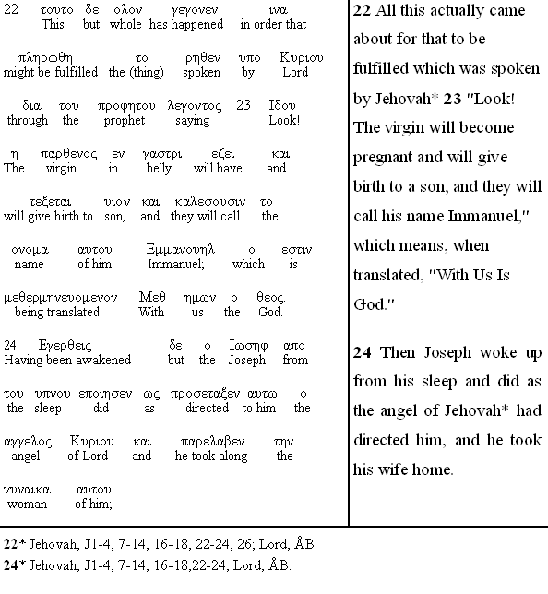
Footnote "J" references and Greek manuscripts
Looking now at the references themselves will help you understand what the footnote means. Since the footnote for verses 22 and 24 cite similar sources, the information in Table 1 applies to both verses. From the footnote information we know that the Tetragrammaton (יהוה) is found in each of the Hebrew versions J1-4, J7-14, J16-18, J22-24, and J26. These versions and their translation[4] dates are as follows:
[4] The Kingdom Interlinear Translation cites J1-4 as translations. However, these four Hebrew documents may actually be copies and editions that come from Matthew's Hebrew Gospel rather than translations from a Greek text as do the remainder of the "J" references. (See The Tetragrammaton and the Christian Greek Scriptures, Chapter 5, Matthew's Gospel in Hebrew on www.tetragrammaton.org.)
| "J" # | Name of Version and Translator | Date |
| J1 | Matthew in Hebrew; Jean du Tillet. | 1555 |
| J2 | Matthew in Hebrew; Shem-Tob-ben-Shaprut. | 1385 |
| J3 | Matthew and Hebrews in Hebrew; Sebastian Munster. | 1537 |
| J4 | Matthew in Hebrew; Johannes Quinquarboreus | 1551 |
| J7 | Christian Greek Scriptures in Hebrew; Elias Hutter. | 1599 |
| J8 | Christian Greek Scriptures in Hebrew; William Robertson. | 1661 |
| J9 | Four Gospels, translated from the Latin Vulgate by John Baptist Jonah. | 1639 |
| J10 | Revision of the Hutter-Robertson Gospels translation by Richard Caddick. | 1800 |
| J11 | Greek Scriptures in Hebrew, T. Fry, G.B. Collyer, and others. | 1817 |
| J12 | Christian Greek Scriptures, W. Greenfield. | 1831 |
| J13 | Christian Greek Scriptures in Hebrew; A. McCaul and others. | 1838 |
| J14 | Christian Greek Scriptures in Hebrew; John Christian Reichardt. | 1846 |
| J16 | Christian Greek Scriptures in Hebrew; John Christian Reichardt and Joachim H. R. Blesenthal. | 1866 |
| J17 | Christian Greek Scriptures, Franz Delitzsch. | 1877 |
| J18 | Christian Greek Scriptures in Hebrew; Isaac Salkinson. | 1885 |
| J22 | Christian Greek Scriptures in Hebrew, United Bible Societies | 1979 |
| J23 | Christian Greek Scriptures, J Bauchet | 1975 |
| J24 | A Literal Translation of the New Testament, Herman Heinfetter | 1863 |
| J26 | Psalms and Matthew 1:1-3:6, Anton Margaritha | 1533 |
From this same verse, a similar (though shorter) list[5] is given for the word Kyrios which is generally translated as Lord. Again, notice the date when these early Greek manuscripts were copied. This footnote information is shown in Table 2.
[5] The number of references to Kyrios (or Lord) passages are fewer in the Kingdom Interlinear Translation only because the editors have chosen to cite so few of the over 5,000 existing Greek manuscripts which are available today. All Greek manuscripts are uniform in their use of Kyrios (or Theos [God]) rather than the Tetragrammaton. The United Bible Societies' Christian Greek Scripture textual apparatus (A Textual Commentary on the Greek New Testament), which shows all textual variants in cited Greek manuscripts, was consulted for each of the 237 Jehovah references. This volume lists all recognized Greek Scripture manuscript variations from which translators must choose. The following count was made for each of the Jehovah references: Seventy-one of the 237 references are specifically discussed in this textual apparatus because there is some textual issue among available Greek manuscripts. However, the presence of the Tetragrammaton is never mentioned for any of these 71 verses, and is therefore not considered as a textual variant in any known Greek manuscript. Further, because the remaining 166 references are not mentioned, we are assured that no basis for textual variants exists in any of the 237 Jehovah references. However, a debate between Kyrios [Lord] or Theos [God] as a possible choice for a specific verse occurs 31 times meaning that both Kyrios and Theos are used in manuscripts available for these 31 verses.
| Manuscript Symbol | Manuscript Name | Date Copied |
| (Aleph) | Codex Sinaiticus, an early uncial Greek manuscript. | 301-400 CE |
| B | Codex Vaticanus (MS No, 1209), an early uncial Greek manuscript. | 301-400 CE |
Comparative dates of supporting evidence
A simple review of the Kingdom Interlinear Translation's footnotes should immediately focus on the dates given for the supporting manuscript/version evidence for either Kyrios (Lord) or the Tetragrammaton in the Christian Greek Scriptures.
We must first ask ourselves this question, "Which evidence is most likely to tell us the exact words the original Scripture writers used?" Will the best evidence come from comparing numerous ancient manuscripts copied within one or two hundred years of the original writing, or will the best evidence come from versions which were translated some 1300 to 1900 years after the original manuscripts were written? Needless to say, the older the manuscript, the closer it is to the original writings. Certainly it can be shown that alterations occurred in very ancient manuscripts, though this limitation is often corrected in reviewing a larger number of manuscripts. Nonetheless, in general the closer the manuscript evidence is to the original documents, the less probability there is of repeated copying mistakes.
It should immediately catch our attention that the footnotes in the Kingdom Interlinear Translation give evidence for the Greek word Kyrios—which is translated Lord—from manuscripts as early as 200 C.E., and quite commonly from 300 to 400 C.E. On the other hand, the evidence given for the Tetragrammaton comes from Hebrew versions that are translations made for Hebrew readers from these same Greek manuscripts which we know do not contain the Tetragrammaton. What is more, these Hebrew translations were done relatively recently with dates no earlier than the late 1300s.[6]
[6] Other downloadable books available from www.tetragrammaton.org comprehensively discuss the issues relating to Hebrew versions. See particularly, The Tetragrammaton in Hebrew Versions or The Tetragrammaton in the Christian Greek Scriptures.
It is surprising to realize that the New World Bible Translation Committee used Hebrew versions published by the Trinitarian Bible Society and its apparent affiliates as "J" references. Mission agencies seeking to spread Christianity among Jews are the primary publishers of Hebrew-language versions. To this end, the LONDON JEWISH SOCIETY published J11, J13, and J16, THE SOCIETY FOR DISTRIBUTING THE HOLY SCRIPTURES TO THE JEWS published J17, and the TRINITARIAN BIBLE SOCIETY published J18. Inspection of the English title pages of these versions shows that the publishers of J17 and J18 apparently worked cooperatively.
Reliance on Hebrew versions to supplant the Greek text of the Kingdom Interlinear Translation is an acknowledgment by the New World Bible Translation Committee that these Hebrew versions carry greater authority in the 237 Jehovah references than do the best extant Greek manuscripts which universally use Kyrios.[1] Consequently, for at least the 237 Jehovah references found in the New World Translation Greek Scriptures, these versions are elevated to the level of inspired Scripture.[2] As a result, we must examine these versions to determine their use of the Tetragrammaton and other titles of God, and not merely the presence of the Tetragrammaton. It is appropriate not only to look at the references that translate Kyrios as Jehovah, but also to evaluate related verses that refer to Hebrew titles for God such as Adonai. Ideally, we would examine all 25 Hebrew versions used for textual support[3] of the Tetragrammaton within the New World Translation Christian Greek Scriptures. We are limited, however, to the two Hebrew versions at hand that, nonetheless, give us an insight into the meaning of the words chosen by the Hebrew version translators.
[1] The Greek word Kyrios appears 714 times in the Greek Scriptures of the Kingdom Interlinear Translation and is translated 651 times as Lord, the title of Jesus. It is used of men 62 times (and once as "Lords") where the New World Translation renders it as "sir," "master," "owner," etc. when applied to individuals other than Jesus. The New World Translation renders it Jehovah 223 times.
[2] We would normally place the emphasis on the original Greek text as the one that was inspired. However, when a later translation from the Greek text is used to establish any word over the known Greek text, the translation itself then becomes a higher standard of authority than the original text.
[3] By textual support we mean "J" version references.
Adonai and Adonenu in appendix descriptions
The New World Translation, Reference Edition, 1984 has several appendices regarding the divine name in Hebrew and other Hebrew language topics. In the remainder of this book, we will identify any one of several Hebrew words as they are written in the Reference Edition's appendix material. In almost all cases, the Hebrew words are transliterated into English letters without accompanying Hebrew letters. In the one instance where Hebrew letters are used for Adonai (Appendix 1B), modern vowel points are not added. In general, we will use the English letters adopted by the Watch Tower Society in our description of the Hebrew text. When transcribing the Hebrew text from either J17 or J18, we will include the vowel pointing, as this adds precision to those who are able to read Hebrew. In some instances, we will transport either the English letters used by the Watch Tower Society into the Hebrew text, or we will bring the Hebrew word into the English text. This will allow more certain identification of the exact word being described.
To the reader unfamiliar with the importance of the divine name, we must give this brief explanation. The divine name is written יהוה (YHWH) in the Hebrew Scriptures. The New World Translation (and a limited number of other English Bibles) appropriately translated these four Hebrew letters (the Tetragrammaton) with the English name Jehovah. In contrast, the Hebrew word Adonai is not a name. Rather it is a title. However, as we will see in the quotation below, during certain periods of Jewish history, Adonai was used in place of the divine name to avoid pronouncing יהוה.
Appendix 1B ( New World Translation, Reference Edition, page 1562) describes Adonai as follows,


Adonai and Adonenu in the Trinitarian Bible Society text
Before going further, we need to explain the difference between Adonai and Jesus' customary title Adonenu. Adonai is rendered as Sovereign Lord in the Hebrew Scriptures of the New World Translation. Appendix 1E (page 1566) of the New World Translation, Reference Edition, 1985, says:
The Hebrew word 'Adho.nai' without an additional suffix always refers to Jehovah God, denoting his sovereign power. Therefore, it is appropriate to render it as "Sovereign Lord."
Thus, in Exodus 4:10 and 13, Moses twice says, "Excuse me Jehovah,"[4] when addressing God using the Hebrew word Adonai. An appropriate English translation is Master, or as generally translated in reference to Jehovah, Sovereign Lord.
[4] See Appendix 1B, page 1562 of the New World Translation, Reference Edition, 1984, for a possible alternate reading.
However, in the Hebrew version identified as J18, Adonenu is generally applied to Jesus. An example of Adonenu used to identify Jesus is found at 1 Thessalonians 1:1.[5] The English wording is from the New World Translation:

[5] At 1 Thessalonians 1:8, this Hebrew version uses the divine name (יהוה with vowel marks) which is translated as Jehovah in the New World Translation. Interestingly, the English portion of this same Hebrew-English volume translates the Hebrew יהוה (with vowel marks) at verse 8 as Lord. It is obvious that this Hebrew version does not separate יהוה from Jesus.
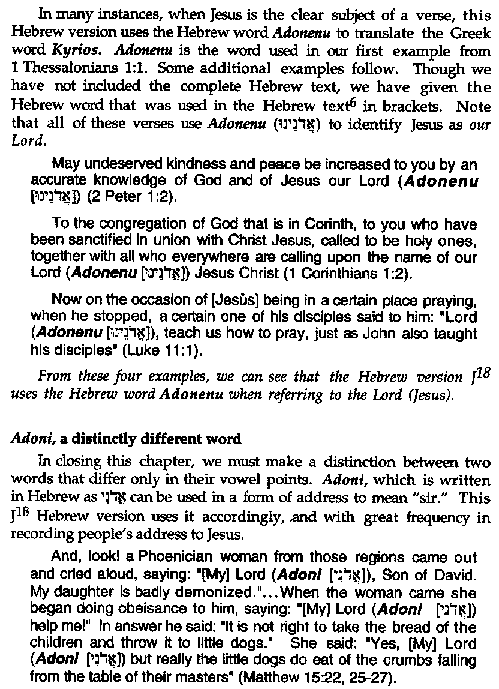
[6] These verses are quoted using the English wording of the New World Translation while showing the Hebrew characters used in the Hebrew version. In each case, the Hebrew word is a translation of the Greek word Kyrios.
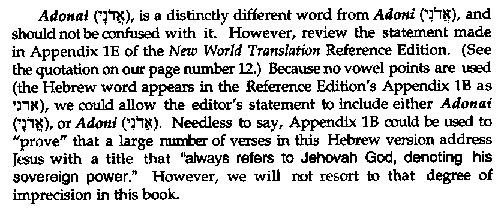
With the background of the previous chapter regarding the Adon family of Hebrew words, we can now look at their actual use in this Hebrew version identified as J18. What might we expect the translation preference of Trinitarian Bible publishers to be regarding the person of Christ? Would Trinitarian Bible publishers separate the personalities represented by the divine name (יהוה) and Kyrios, or would they unite their identity? (Clearly, the New World Translation has separated their identity in order to avoid a united identity between the Father and Jesus.)
On page 18 of the Foreword of the 1969 edition of the Kingdom Interlinear Translation, the translators say:
When coming upon quotations from the Hebrew Scriptures where the [divine] Name appeared, the translators in Hebrew had no other recourse than to render ky'ri.os or the.os' back into its original Tetragrammaton form יהוה. (Emphasis added.)
This can be easily verified with any Hebrew version. If, for instance, all Kingdom Interlinear Translation footnote references to J18 are consulted, the Tetragrammaton will be found in the indicated verse citations. We would expect that all "J" references in the Kingdom Interlinear Translation are correct and that each of these Hebrew versions uses the Tetragrammaton as indicated.[1]
[1] The one exception to this statement will be the Shem-Tob version that uses the circumlocution "The Name" rather than the Tetragrammaton. Thus, all J2 references in Matthew stand for "The Name" rather than יהוה. The Watch Tower Society recently confirmed Matthew's circumlocution in J2 even though reference to it is not made in current editions of KIT.
However, though the statement quoted above is generally true, it is not always the case! There are two notable exceptions. Both 1 Peter 2:3 and 1 Peter 3:15 were problematic verses for the translators of the New World Translation. However, for the moment we are considering only the translation preference of this Trinitarian Bible publisher.
1 Peter 2:3 quotes Psalm 34:8 which says, "Taste and see that Jehovah (יהוה) is good, O YOU people." It is interesting to see how this Hebrew version translates the verse. 1 Peter 2:3 in this Hebrew version is written in both Hebrew and English as follows:
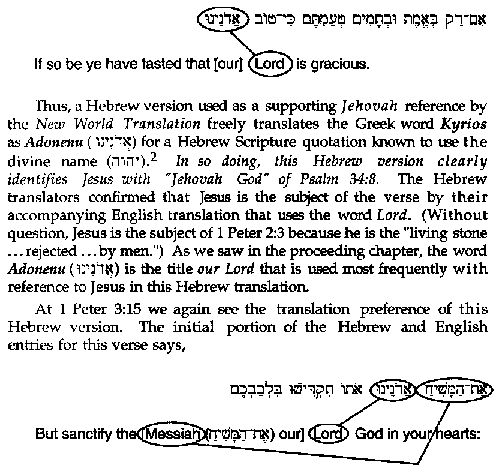
[2] Another "J" reference, A Concordance to the Greek Testament by Moulton and Geden which is identified in KIT as J20, cites Psalm 34:8 and יהוה at 1 Peter 2:3. In spite of the Translation Committee's statement that such a verse should be translated as Jehovah because it is a quotation of a Hebrew Scripture verse using יהוה, they ignore their own rule and translate this verse with Lord because of its reference to Jesus. (For reference see the quotation at the beginning of this chapter from page 18 of the forward in KIT.)
Unmistakably, this Hebrew version uses Jesus' title Lord within a verse that is again quoted from a Hebrew Scripture reference employing the divine name (יהוה). Certainly, two instances are a small number as compared with a total of approximately 90 verses in the Christian Greek Scriptures that quote Hebrew Scripture references using the Tetragrammaton. Nonetheless, the statement is false which says,
When coming upon quotations from the Hebrew Scriptures where the [divine] Name appeared, the translators in Hebrew had no other recourse than to render ky'ri.os or the.os' back into its original Tetragrammaton form יהוה.
The wording "no other recourse" in the above quotation is incorrect. In at least two instances, the translators of this Hebrew version used Hebrew Scripture quotations containing the Tetragrammaton (יהוה) and translated יהוה into the title for Jesus meaning "our Lord" (Adonenu).
Confirmation of the Translation Committee's statement
On the other hand, we find an interesting confirmation of the Translation Committee's statement in J17. In this instance, the translator of J17 realized that 1 Peter 3:15 was a true quotation of Isaiah 8:13 which used the divine name. Therefore, he translated the Greek word Kyrios as יהוה. This passage is also verified in J20 as being a quotation of Isaiah 8:13.
The first portion of the verse appears in both J17 and the New World Translation as follows:

The New World Bible Translation Committee did not insert Jehovah into the English text of this verse even though a Hebrew version used the Tetragrammaton. Even more, they failed to add Jehovah in spite of the fact that the Kingdom Interlinear Translation "J" reference footnote lists J7, J8, J12, J13, J14, J16 and J17 as containing the Tetragrammaton.
haAdhon in the Trinitarian Bible Society text
We find another unexpected use of translated words in the Hebrew version J18.
However, before turning to the passages themselves, we must review another citation from Appendix 1H of the New World Translation Reference Edition that says:

[3] The reader should be aware that this statement is not fully acceptable to a majority of Hebrew scholars. However, inasmuch as this has been a principle followed in the Hebrew Scripture translation of the New World Translation, it should be expected that it would equally apply to the use of Hebrew versions in the New World Translation's rendition of the Christian Scriptures.
The reader would be surprised to peruse both
J17 and J18 and discover that the
translators have frequently used this title of Jehovah himself to
identify the Lord Jesus. In many instances, this
identification is made only by the context within the Hebrew
text. (That is, ![]() is used in a Hebrew passage which is essentially talking
about Jesus. In some cases, the passage may accommodate moving
alternately between the subjects of Lord and
Jehovah. In other cases, however, the subject is the
Lord Jesus and cannot be understood to mean
Jehovah.) In all cases from which these examples were
taken, the accompanying English text published as an integral
part of J17 or J18 includes the English
word Lord.
is used in a Hebrew passage which is essentially talking
about Jesus. In some cases, the passage may accommodate moving
alternately between the subjects of Lord and
Jehovah. In other cases, however, the subject is the
Lord Jesus and cannot be understood to mean
Jehovah.) In all cases from which these examples were
taken, the accompanying English text published as an integral
part of J17 or J18 includes the English
word Lord.
The following illustrations are quoted directly from the English portion of J18. The Hebrew word that is used in this version is inserted into the text in parentheses. Also included in the parentheses is the definition of this Hebrew word as given in the appendix of the New World Translation with the customary translation enclosed in brackets. Many additional illustrations could be given.
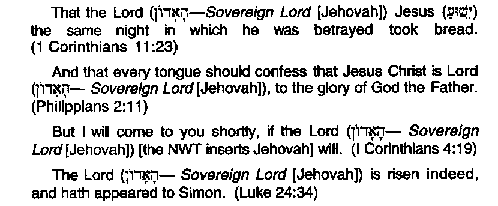
Notice carefully how the New World Bible
Translation Committee handled this Hebrew word. According to
their own grammatical rule, haAdohn [![]() ] is translated as
Jehovah at 1 Corinthians 4:19 and 1 Corinthians 7:17. (See
this book's appendix for 1 Corinthians 7:17.) However, a simple
verification within the New World Translation of the
remaining three verses used in this example indicate that the New
World Bible Translation Committee did not follow their own rule
at 1 Corinthians 11:23, Philippians 2:11, or Luke 24:34. From the
appendix information given at the end of this book, we see that
from just 1 Corinthians alone, haAdohn appears 19
times. Of these 19 occurrences, however, it is translated as
Lord 16 times in the New World Translation, and as
Jehovah 3 times. (See the Appendix: HaAdohn in
J17—First Corinthians for the discussion of
these 1 Corinthians passages.)
] is translated as
Jehovah at 1 Corinthians 4:19 and 1 Corinthians 7:17. (See
this book's appendix for 1 Corinthians 7:17.) However, a simple
verification within the New World Translation of the
remaining three verses used in this example indicate that the New
World Bible Translation Committee did not follow their own rule
at 1 Corinthians 11:23, Philippians 2:11, or Luke 24:34. From the
appendix information given at the end of this book, we see that
from just 1 Corinthians alone, haAdohn appears 19
times. Of these 19 occurrences, however, it is translated as
Lord 16 times in the New World Translation, and as
Jehovah 3 times. (See the Appendix: HaAdohn in
J17—First Corinthians for the discussion of
these 1 Corinthians passages.)
HaAdohn [![]() ] is used frequently of Jesus in these two
Hebrew versions. The New World Bible Translation Committee says
that haAdohn means "The [true] Lord" [and that] the use of
the definite article ha before the title 'A.dhohn'
limits the application of this title exclusively to Jehovah God."
Yet, we find a very high frequency of this term in these Hebrew
versions. The reader should be aware that these Hebrew versions
use haAdohn frequently, and apply it to Jesus.
] is used frequently of Jesus in these two
Hebrew versions. The New World Bible Translation Committee says
that haAdohn means "The [true] Lord" [and that] the use of
the definite article ha before the title 'A.dhohn'
limits the application of this title exclusively to Jehovah God."
Yet, we find a very high frequency of this term in these Hebrew
versions. The reader should be aware that these Hebrew versions
use haAdohn frequently, and apply it to Jesus.
It is disturbing to realize that the New World Bible Translation Committee translated haAdohn as Jehovah in two instances verified in this study, but as Lord in the majority of instances when the Hebrew version's use of haAdohn affirms a divine nature of Jesus.
Other insights from the appendix information
Many interesting insights come from reviewing the information coming from J17 in this book's appendix. The information is summarized in the appendix table entitled All Kyrios reference totals for 1 Corinthians. Initially, we can verify that the "J" references accurately report the occurrences of יהוה in this Hebrew version. The footnote "J" references of the Kingdom Interlinear Translation cite 8 instances of יהוה in 1 Corinthians that we can verify in the text.
Within 1 Corinthians, we also realize that the single word Kyrios in the Kingdom Interlinear Translation is translated as Jehovah 15 times and as Lord 51 times in the New World Translation. When we examine each entry carefully, we realize that J17 has similarly translated Kyrios as both יהוה and haAdohn. (Three times as יהוה and 16 times as haAdohn.) However, when we read each entry with its accompanying English translation, we realize that the Hebrew version is not separating the identities of haAdohn and יהוה by making them distinctly different. J17 freely uses Lord in the parallel English translation of both haAdohn and יהוה.
We make another rather unexpected observation when evaluating the appendix information from J17. We discover that at 4:19, 10:9, 21 (twice), 22, and 11:32, the Hebrew versions do not agree regarding the translation of the Greek word Kyrios to יהוה. Thus, according to the "J" references at 10:9, and 11:32, there are only three versions that actually use יהוה. In three other instances, there is agreement between only four Hebrew versions. Conversely, it means that the remaining 22 versions (or 21 versions where there are four citations) do not contain the Tetragrammaton. Thus, we realize that the Translation Committee did not explain an important translation criteria. What strength of support was necessary in order to alter the known wording of the Greek text of the Kingdom Interlinear Translation from Lord to Jehovah? Did all Hebrew versions need to agree, or could only three Hebrew versions sway the Translation Committee even when all remaining versions used different vocabulary? The importance of this translation criteria is particularly obvious at 1 Corinthians 10:9. If the New World Translation had not used Jehovah at 1 Corinthians 10:9, the verse would have attributed to Jesus close identity with Jehovah of the Hebrew Scriptures.
None of these comments endorse the theological predisposition of J17. It certainly raises a question, however, as to why the New World Bible Translation Committee chose to use these Hebrew versions when the clear intent of at least two of them is to identify Jesus as haAdohn with יהוה.
J17 and J18's identification of יהוה with Lord
Some of the Hebrew versions produced in English speaking countries were printed as two-language translations. That is, they had both Hebrew and English parallel texts. They were not produced as interlinear translations with one word-for-word text over the other. Rather, they gave an unbroken Hebrew text on one page and an English text on the facing page. Both J17 and J18 are produced in this format.
This facing-page arrangement of the text allows us to compare the Hebrew and English texts. For obvious reasons, neither a translator nor a conscientious Bible publisher would produce a two—language Bible that-in their point of view—contained gross inconsistencies between the two texts.
Therefore, we can use this Hebrew-English arrangement as a commentary for the intended meaning of יהוה in the Hebrew translation. It would interest the reader to glance through either J17 or J18 and notice the parallel passages where the Tetragrammaton is used in the Hebrew text. Almost without exception, the English text reads Lord.
We cannot give this evidence more weight than it merits. It is not, in fact, a written statement by the translator that he considers the Tetragrammaton and the word Lord to have exact equivalence. Nonetheless, it is an interesting fact that this arrangement occurs.
Throughout this book we have sought evidence that would indicate the bias of these Hebrew version translators. We can only present the following comment as being suggestive. Nonetheless, in light of our other observations of these translator's use of vocabulary choices to closely identify Jesus with Jehovah, it is undoubtedly significant that they use two-language texts which appear to have an exact equivalence between יהוה and Lord. The indication is that these Hebrew version translators understood the divine name יהוה to properly describe Jesus as Lord.
A summary
We began this section with the question, "What
might we expect the translation preference of Trinitarian
Bible publishers to be regarding the person of Christ?" From this
brief examination, it appears that at least these two Hebrew
versions unite the identities represented by the divine
name (יהוה) and Kyrios. That is,
rather than delineating between them, these two versions will,
on occasion, identify Jesus himself as the Sovereign Lord
haAdohn (![]() ). (See particularly Luke 24:34 above and the
information in this book's Appendix.) Notwithstanding the last
statement, these same two Hebrew versions also freely use the
divine name (יהוה) when the Hebrew
translators deemed it appropriate to do so.
). (See particularly Luke 24:34 above and the
information in this book's Appendix.) Notwithstanding the last
statement, these same two Hebrew versions also freely use the
divine name (יהוה) when the Hebrew
translators deemed it appropriate to do so.
At least these two[4] Hebrew versions identify Jesus with Hebrew titles of deity in stark contrast to the identification that he is given in the New World Translation. The Hebrew version translators use the Tetragrammaton (יהוה) when translating verses quoted from the Hebrew Scriptures. Concurrently, when an inspired Christian Greek Scripture writer identifies the Lord Jesus within a verse containing a Hebrew Scripture quotation such as 1 Peter 2:3 and 3:15, these Hebrew translators also freely identify our Lord Adonenu as the subject. (In the case of J17, the Hebrew translator actually identifies Jesus as יהוה.) The identification of our Lord [Jesus] with Jehovah (יהוה) is unmistakable in these two Hebrew versions.
[4] Both Hebrew versions used in this study were compared, showing similar (though not identical) word usage. The primary study was done from J18. The second Hebrew version J17 was compared in the case of 1 Peter 2:3 and 3:15. At 1 Peter 2:3, this second version uses haAdohn () with the meaning the [true] Lord, or Jehovah. As noted earlier, the second version clearly uses the Tetragrammaton with modern vowel points at 1 Peter 3:15. After seeing this difference in the Hebrew translators' choice of words, the reader understands that all Hebrew versions must be evaluated independently. We cannot make generalized statements from these two Hebrew versions that universally apply to all "J" references.
As previously mentioned, it is also noteworthy that the English texts of these two Hebrew versions do not use the English word Jehovah when the Tetragrammaton occurs in the Hebrew text. Rather, Lord is the English word used to translate יהוה.
After examining these Hebrew versions, we also
realize that the translators of the New World Translation
have been selective in the use of "J" references. In the Hebrew
Scriptures, they have always translated haAdohn (![]() —Sovereign
Lord) as Jehovah. However, in our own independent study of
one Hebrew version, we find that the Committee translated this
same word three times as Jehovah and 16 times as
Lord in a single Christian Scripture book. Were we to
search through the entire list of 714 Kyrios references in this
Hebrew version, we most certainly would see the same translation
pattern repeated many times. Every appearance is that the New
World Bible Translation Committee's translation work favored a
theological predisposition rather than the grammatical rules they
established for the translation process.
—Sovereign
Lord) as Jehovah. However, in our own independent study of
one Hebrew version, we find that the Committee translated this
same word three times as Jehovah and 16 times as
Lord in a single Christian Scripture book. Were we to
search through the entire list of 714 Kyrios references in this
Hebrew version, we most certainly would see the same translation
pattern repeated many times. Every appearance is that the New
World Bible Translation Committee's translation work favored a
theological predisposition rather than the grammatical rules they
established for the translation process.
Why did the translators of the New World Translation selectively use certain verses from these Hebrew versions to "reinstate the divine name," while at the same time carefully avoiding any mention of these "Trinitarian" versions' identification of "our Lord" with the divine name (יהוה) of the Hebrew Scriptures?
We will now look at three accounts of the conversion of Saul on the road to Damascus. The first is Luke's account at Acts 9:1-11. The remaining two accounts are those given by Paul himself as he recounts the same event before the Jewish mob at Acts 22:6-10, and before King Agrippa at Acts 26:13-16. We will insert the Hebrew words from the Hebrew versions that parallel the word Lord in these accounts.
From the appendix statement of the New World
Translation that we saw in the last chapter, we understand
that haAdohn (![]() ) is a title limited exclusively to Jehovah God. As
we have just seen, we also know that Adoni (
) is a title limited exclusively to Jehovah God. As
we have just seen, we also know that Adoni (![]() ) refers to Jesus as
My Lord.
) refers to Jesus as
My Lord.
With the above definitions of these two Hebrew words, notice what the Hebrew translators of J18 intended to communicate to their readers. (Some citations are from the Hebrew version J17.) The passages are quoted from the New World Translation. The Hebrew word used in this version with the meaning as defined within the New World Translation is inserted in brackets.
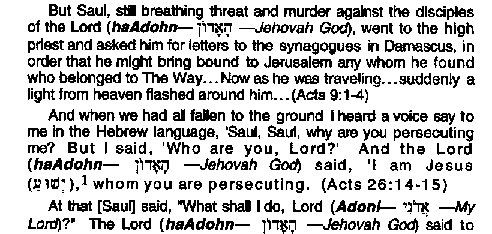
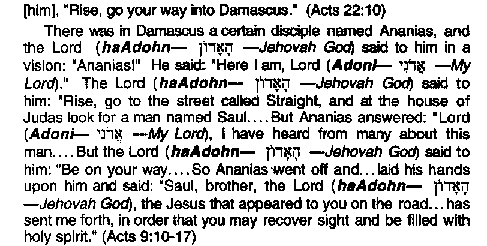
[1] This is an extremely significant construction in the Hebrew version. Saul as the person speaking says, "Who are you Lord?" The answer is given in this Hebrew version reading from right to left:

Literally translated, the Hebrew says, "Jehovah God said 'I am Jesus.'"
Little needs to be said after reading the passages above. We must merely ask ourselves again why the translators of the New World Translation so purposely overlooked passages such as the ones above which address (or identify) Jesus with Hebrew words aligned with the divine name. Does it reflect translation integrity to use J17, J18 and other Hebrew versions to reinstate the divine name in conveniently selected passages, and yet ignore evidence when it does not support a theological position?[2]
[2] In all fairness, there is another answer to this dilemma. Modern Hebrew scholars would depend on context to determine whether or not the translation for these verses was properly Jehovah God or Sovereign Lord which they would equate with an address to deity but which would not require the use of the divine name. However, were we to make this allowance for the translation of this particular passage, we would be forced to disallow the grammatical rules used by the New World Bible Translation Committee which permitted Jehovah to be reinstated into the Christian Greek Scriptures in the first place.
Hebrew versions and the inspired text
Because of the status given to the Tetragrammaton in these Hebrew translations, we must close this chapter with a brief discussion of textual canonicity.[3] Under normal circumstances, the words used by the inspired Christian writer cannot be verified by consulting a relatively recent version.
[3] The word canon comes from the Latin word kanon, which refers to a measuring rod. The idea in English is the rule or standard by which something is measured. Specifically, the Bible canon came to denote the catalog of inspired books worthy of being used as a straightedge in measuring faith, doctrine, and conduct. (Aid to Bible Understanding, page 290). The canon, as used here, is the list of the 66 books accepted as inspired Scripture.
For example, Revelation 1:8 reads as follows in the 1910 text of the recognized French Protestant Bible by Louis Segond:
Je suis l'Alpha et l'Oméga, dit le Seigneur Dieu, celui qui est, qui était, et qui vient, le Tout-Puissant.
This is translated into English as:
I am the Alpha and the Omega says the Lord God, he who is, who was, and who will be, the All-Powerful.
The word Signeur is the French equivalent of our English word Lord and is used of Jesus throughout the Louis Segond Nouveau Testament [New Testament]. The French word Dieu is the English word God. Irrespective of the theological bias we might find in the juxtaposition of the words Lord and God in this French version, we could not use this translation to prove that the original Greek writers used a certain wording in their Greek text. We must seek the information we need from a reliable Greek text rather than from a French translation.
This would normally be true of all textual searches for the original wording of the inspired Christian writers. We would consult the Greek text from which the translation was made rather than recent versions.[4] Consequently, were it not for the New World Bible Translation Committee's reliance on Hebrew versions, the content of this entire book would be a moot point.
[4] The use of early versions, however, represents a different level of textual certainty. A version from the third or fourth century may give valuable insights into the original text's wording by suggesting the word the translator saw in the Greek text from which he was translating. Nevertheless, the evidence is merely corroborative. Evidence from even a very early version could never have precedence over the known Greek text from which that version was translated.
We have a unique situation, however, in the case of the Hebrew versions cited in the New World Translation. In this case, the Hebrew versions have been elevated to a higher status than the inspired canonical writings when they are used to countermand the best extant Greek texts. Thus, in this book we have considered the use of two Hebrew versions and their employment of divine titles for Jesus. Under normal circumstances, the use of Hebrew words such as Adoni (My Lord), haAdohn (Jehovah God), or Adonai (Sovereign Lord) would simply suggest an inconsequential footnote within the translation process.
If, however, the argument is made that the presence of the Tetragrammaton in these versions supersedes the Greek text of the Kingdom Interlinear Translation, then by that same reasoning, we are forced to use the Hebrew versions' entire vocabulary concerning the person of Christ to define our understanding of inspired Scripture.
It is the author's personal opinion, however, that late versions do not dictate the contents of the original inspired Scriptures. According to the author's opinion, the correct wording of the Christian Scriptures is based on the best textual evidence available from ancient extant Greek manuscripts themselves.
Hebrew versions are the only manuscript evidence to which the New World Translation can appeal for the 237 Jehovah references in the Christian Scriptures. This book has not evaluated either the issue of the purported heresy of the second and third centuries credited with removing the Tetragrammaton from the original Christian Scripture manuscripts, nor the strength of Hebrew versions as critical texts allowing restoration of the divine name to the Christian Scriptures. (See the free downloadable books available through www.tetragrammaton.org for information on these and related topics.) However, irrespective of the claims for the Tetragrammaton's removal, the Watch Tower Society itself recognizes that there are no manuscripts remaining today giving evidence that the inspired Christian Scripture writers wrote the divine name in Hebrew letters.[1] Consequently, the only manuscript evidence the New World Translation cites supporting Jehovah in the Christian Scriptures is the testimony of Hebrew versions.
[1] There is ample evidence that the Tetragrammaton was used in the Septuagint (the Greek language translation of the Hebrew Scriptures available in Jesus' day). However, of the more than 5,000 available copies of ancient Greek Christian Scripture manuscripts-some from as early as 200 C.E.-there are no manuscripts that show any evidence of the Tetragrammaton.
The New World Bible Translation Committee used 25 Hebrew versions as the basis for altering the Greek text of the Kingdom Interlinear Translation in 237 instances. In so doing, they have elevated these versions to the level of inspired Scripture. It is therefore entirely appropriate that these Hebrew versions be subjected to the same exacting scrutiny required of any other manuscript evidence used to correct the Greek manuscript transmission process.
Because Hebrew versions are seldom available to readers of the New World Translation, this book evaluated two of these Hebrew versions. J18 was the primary reference with supplementary information taken from J17. From both the statements of the New World Bible Translation Committee and from selected passages found in these two Hebrew versions, we have discovered the following:
The statement from the Kingdom Interlinear Translation (Foreword, 1969 edition) that says, "When coming upon quotations from the Hebrew Scriptures where the [divine] Name appeared, the translators in Hebrew had no other recourse than to render ky'ri.os or the.os' back into its original Tetragrammaton form יהוה," is not always true. In at least two instances (1 Peter 2:3 and 1 Peter 3:15), a verse containing the Tetragrammaton (יהוה) in the Hebrew Scriptures is translated as Lord (Adonenu) in J18. Adonenu is frequently used for Jesus throughout the Hebrew version Greek Scriptures.
Nonetheless, in the case of J17, the Hebrew translator does follow this pattern when recognizing יהוה from Isaiah 8:13. In this case, he identifies Jesus (the Christ) as Jehovah of Armies at 1 Peter 3:15.
Appendix 1H of the New World Translation Reference
Edition says, "The title 'A.dhohn', 'Lord;
Master,' when preceded by the definite article
ha, 'the,' gives the expression
ha.'Adhohn', 'the [true] Lord.' The use of the
definite article ha before the title
'A.dhohn' limits the application of this title
exclusively to Jehovah God." However, the translators of the
Hebrew versions J17 and J18 used this
title of Jehovah himself to identify the Lord Jesus. In the
verses we examined at Acts 9:1-11, Acts 22:6-10, Acts
26:13-16, and 16 times in 1 Corinthians, these two Hebrew
versions used haAdohn (![]() ) in reference to
Jesus, which is a title limited exclusively to Jehovah
God.
) in reference to
Jesus, which is a title limited exclusively to Jehovah
God.
The most disturbing evidence, however, comes from J17. From 1 Corinthians we discover that the New World Bible Translation Committee translates haAdohn as Jehovah three times and as Lord 16 times. HaAdohn was selectively translated as both Jehovah and Lord, suggesting that the selection was possibly based on a theological predisposition rather than the Committee's stated grammatical translation rules.
The Hebrew version identified as J18 evidences a translation preference. As we might expect of a Trinitarian Bible publisher, this version clearly unites the identities of the personalities represented by the divine name (יהוה) and Kyrios. A Hebrew-language reader would clearly understand that the two Hebrew versions evaluated in this study purposefully represent Jesus as identifiable with the nature of Jehovah of the Hebrew Scriptures.
The New World Bible Translation Committee was selective in its choice of evidence from the two Hebrew versions we evaluated. Though it freely used these versions to reinstate the divine name into the Christian Greek Scriptures where it could do so by attributing divine characteristics to Jehovah, it omitted any reference to numerous passages that clearly identify Jesus with the divine name of the Hebrew Scriptures.
There is no lost Greek text containing יהוה
With all of the discussion of the Tetragrammaton that was supposedly removed from the early copies of the Christian Greek Scriptures,[2] the reader will often assume that the textual source for these Hebrew versions is a lost Greek text that contains manuscript verification of the Tetragrammaton (יהוה) in Hebrew letters. There are two observations we can make from the study we have just completed which completely dispel any notion that there are "lost" Greek manuscripts behind these Hebrew versions.
[2] For a complete discussion of the presumed presence of the Tetragrammaton in the Christian Greek Scriptures and its subsequent removal, see the book The Tetragrammaton and the Christian Greek Scriptures. This meticulously documented 360 page book is available for purchase or can be downloaded at no cost from www.tetragrammaton.org and other religious information web sites.
The first is the statement of the New World Bible Translation Committee that there are no "lost" Greek manuscripts that contain the Tetragrammaton. We have already examined the quotation from page 18 of the Foreword of the 1969 edition of the Kingdom Interlinear Translation wherein the translators say:
When coming upon quotations from the Hebrew Scriptures where the [divine] Name appeared, the translators in Hebrew had no other recourse than to render ky'ri.os or the.os' back into its original Tetragrammaton form יהוה.
The Translation Committee is openly telling us that the work of producing a Hebrew version was done by translators in Hebrew. Obviously, these men were translating from another language into Hebrew. That is, the Hebrew translators were not working from Hebrew-language manuscripts. But further, the Translation Committee tells us that these translators were working with Greek manuscripts because they contained kyrios and theos, the words for Lord and God. We can properly assume from this that these translators were working from the currently available Greek texts that do not contain the Tetragrammaton. At the very least, the manuscripts they were using did not contain יהוה in a Greek text.
The evidence from the Hebrew versions themselves state that these translations were made from Greek texts. An interesting comment appears on the title page of both J17 and J18. Both identically read,[3]
TRANSLATED OUT OF THE ORIGINAL GREEK: AND WITH
THE FORMER TRANSLATIONS DILIGENTLY COMPARED
AND REVISED, BY HIS MAJESTY'S SPECIAL COMMAND.
[3] Reproductions of this title page can be seen in both The Tetragrammaton and the Christian Greek Scriptures, and the book The Tetragrammaton and Hebrew Versions. Both are available as free downloadable books on www.tetragrammaton.org and other religious web sites.
Therefore, these Hebrew versions do not move us closer to an early manuscript form of the Christian Greek Scriptures. They move us farther away by interposing a translation between our modern translation and the most accurately restored Greek texts.
The single merit of these Hebrew versions as resource material is their reflection of the viewpoint of Hebrew translators who are both fluent in Hebrew and yet have come to acknowledge Jesus as Israel's true Messiah. That viewpoint, as we have already seen, leads the translators of both J17 and J18 to make a close identification between Jesus and Jehovah.
A concluding thought
The Hebrew versions have been used by the New World Bible Translation Committee to reinstate the name of Jehovah into the Christian Scriptures. Most readers will assume, therefore, that the translators of these versions are biased to make a clear distinction between Jesus and Jehovah. That is, by using the Tetragrammaton in 237 instances, they are separating any identity of equality between Jehovah and the Lord Jesus.
Certainly the above statement may be true in some cases. We know that Shem-Tob's Matthew is an appendix to his argument for a Jewish audience that Jesus was not the promised Messiah. George Howard[4] says,
With the possible exception of [Matthew] 16:16...the author of Shem-Tob's Matthew never identifies Jesus with the Christ [Messiah]. This is to be contrasted with the Greek text [the Christian Greek Matthew as we know it], where the Christ identification is clearly made.
[4] Hebrew Gospel of Matthew by George Howard, Mercer University Press, 1995, page 216. This is a fascinating book and well worth reading. Howard has done an important study on this Hebrew text. Howard asserts that this is not a version (translation) but is rather a recension of the actual Matthew Gospel written by the Apostle.
Yet, when we examine at least two of these Trinitarian Hebrew versions, we discover just the opposite. We discover that these Hebrew translators are using common constructions and vocabularies in modern Hebrew to achieve an entirely different objective. They are clearly attempting to identify Jesus with Jehovah. For example, consider one verse we have already seen.
The translator of J18 uses the vocabulary that the New World Bible Translation Committee affirms,
The title 'A.dhohn', "Lord; Master," when preceded by the definite article ha, "the," gives the expression ha.'Adhohn', "the [true] Lord." The use of the definite article ha before the title 'A.dhohn" limits the application of this title exclusively to Jehovah God.
Philippians 2:11 is then translated in this Hebrew version as,
And that every tongue should confess that Jesus Christ is Lord (haAdohn—Sovereign Lord [Jehovah]), to the glory of God the Father.
Any Jewish reader of J18 would understand the quotation at Philippians 2:11 as coming from Isaiah 45:21-24 which says:
"Is it not I, Jehovah, besides whom there is no other God…By my own self I have sworn…that to me every knee will bend down, every tongue will swear, saying, 'Surely in Jehovah there are full righteousness and strength.'"
Very clearly, the translator of J18 is giving Jesus the identity of Jehovah "Besides whom there is no other God [to whom] every knee will bend down, [and] every tongue will swear." This translator has made this identification through a choice of translation vocabulary clearly understood by a Hebrew-language reader to identify Jesus with this one God "[to whom] every knee will bend down, [and] every tongue will swear." We saw the same choice of vocabulary when the translator of J17 quoted Jesus as answering Saul from heaven saying,
Literally translated, the Hebrew says, "And Jehovah God said 'I am Jesus.'"
We must therefore conclude that at least some of these Hebrew version translators were clearly attempting to identify Jesus with Jehovah in order to prove his full identity as Almighty God.
Therefore we must ask, "Can the New World Bible Translation Committee truthfully use these Hebrew versions to make a distinction between Jehovah (יהוה) and Jesus without telling us that the apparent purpose of these Hebrew versions—and the frequent vocabulary throughout—was selected by their translators to do just the opposite? Can they truthfully select a mere 237 references without context—while actually excluding references that identify Jesus as יהוה—and ignore a far greater body of evidence in these Hebrew versions of the identification of Jesus with the Glory of Jehovah God himself?"
Appendix: HaAdohn in J17—First Corinthians
In Chapter 4, we quoted Appendix 1H of the New World Translation Reference Edition which says:

[3] As already noted in Chapter 4 this statement is not fully acceptable to a majority of Hebrew scholars. However, inasmuch as this has been a principle followed in the Hebrew Scripture translation of the New World Translation, it should be expected that it would equally apply to the use of Hebrew versions in the New World Translation's rendition of the Christian Scriptures.
The haAdohn table for 1 Corinthians
The following table lists all the Kyrios (Lord) verses found in 1 Corinthians. The purpose of this study is to evaluate the number of occurrences of the Hebrew word haAdohn in a randomly selected Christian Scripture book. According to the statement above, all references to haAdohn—whether in the Hebrew Scriptures or in a Hebrew version—should be translated Jehovah in the New World Translation.
The 1 Corinthians table
Under the heading Hebrew version J17, the word under study is written in Hebrew letters exactly as it appears in the Hebrew version, followed by an English transliteration column. (The English transliteration does not appear in J17.) J17 is a two-language Bible. The English text and the Hebrew text appear on facing pages. The word(s) in the English translation column are quoted directly from the English text of this Hebrew version.
Three columns appear under the heading Kingdom Interlinear Translation. The column "J" reference lists the citations for each occurrence of a Jehovah reference exactly as it appears in the Kingdom Interlinear Translation. (This same "J" reference list is reproduced in the footnotes of the New World Translation, Reference Edition). When the Tetragrammaton is shown in column 2, there is always a reference to J17 in the "J" reference column. The citation can also be compared with other Hebrew versions that use the Tetragrammaton in that verse. In the column Greek word, an English transliteration is given of the Greek word used in the Kingdom Interlinear Translation. (A table at the end of this appendix gives the Greek word used for the English transliteration.) The column English word lists the actual translation word used in the Kingdom Interlinear Translation for the corresponding Greek word.
The last column headed NWT gives the word used in the New World Translation for this corresponding Hebrew and Greek word.
A bullet (o) identifies each reference in 1 Corinthians where haAdohn is used without any prefix or suffix modification.
A dagger (†) identifies each occurrence of the Tetragrammaton (יהוה) in J17.
A not-equal symbol (≠) identifies a reference that does not use the Tetragrammaton in J17 even though it is found in other "J" references.
Chapter 4 discusses this table in further detail.
Table notes
Note 1: Neither the Hebrew word Adoneneu
nor haAdohn is used.
Note 2: This version uses the word for Messiah in the
Hebrew text and Christ in the English text.
*The vowel points in יהוה are from
Adonai making transliteration
unintelligible.
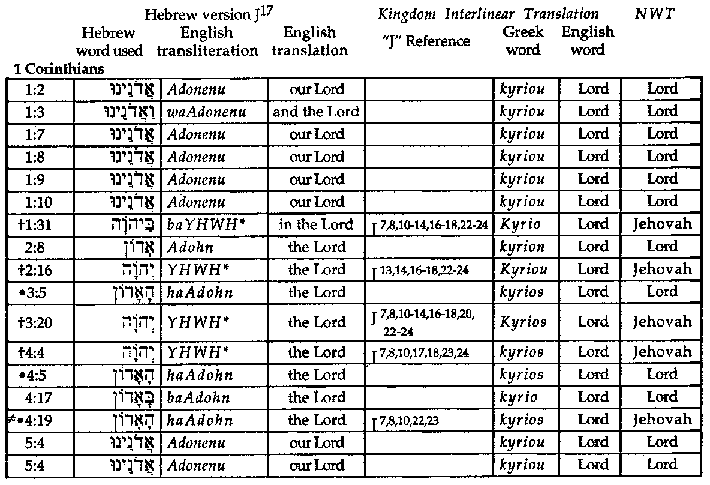
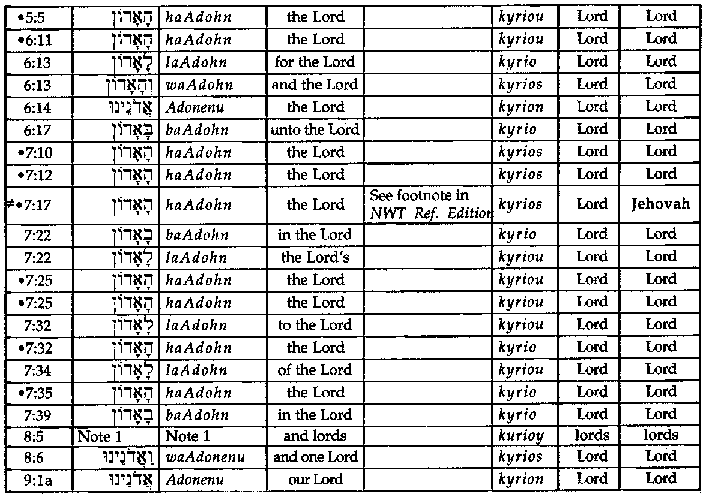
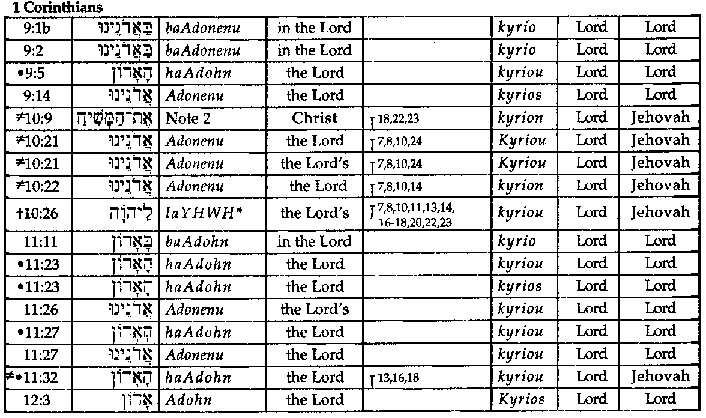
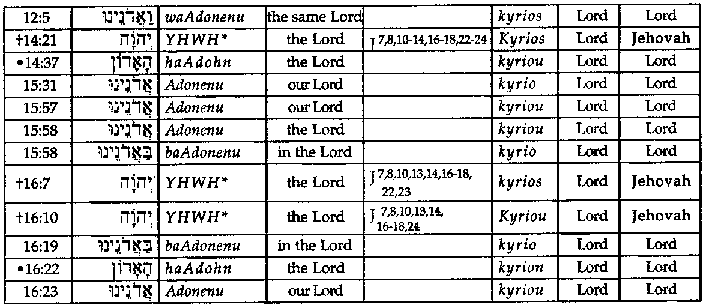
All Kyrios reference totals for 1 Corinthians
| Kyrios (Lord) verses in 1 Corinthians | 67 | |
| Translated as Jehovah in NWT | 15 | |
| Translated as Lord in NWT | 51 | |
| Translated as lords in NWT | 1 | |
| HaAdohn occurrences at Kyrios verses in J17 | 19 | |
| Translated as Jehovah in NWT | 3 | |
| Translated as Lord in NWT | 16 | |
| יהוה occurrences* at Kyrios verses in J17 | 8 | |
| Translated as Jehovah in NWT | 8 | |
| Adonenu occurrences** at Kyrios verses in J17 | 26 | |
| Adohn occurrences** at Kyrios verses in J17 | 12 | |
| Other Hebrew words at Kyrios verses in J17 | 2 | |
| NWT Jehovah references at Kyrios verses in J17 | 15 | |
| With support from both J17 and other "J" references | 7 | |
| Without J17 but supported from other "J" references | 7 | |
| Without any "J" reference support | 1 | |
*Including the forms
laYHWH and baYHWH.
**Incudes all forms with
prefixes ba, wa and la.
Greek transliteration table
| Greek word in the Kindgom Interlinear Translation |
English Transliteration |
| κύριος | kyrios |
| κυρίου | kyriou |
| κύριον | kyrion |
| κύριοι | kurioi |
| κυρίω | kyrio |
The noun must agree with (or be identified by) its function in a Greek sentence. This is achieved by spelling changes in the suffix (ending letters) of the word. Thus, each form of the word kyrios in this appendix is derived from the same root word, though the spelling is altered according to its grammatical function in the sentence.
The Watch Tower transliteration spelling preference Kyrios (rather than Kurios) is used in this appendix.